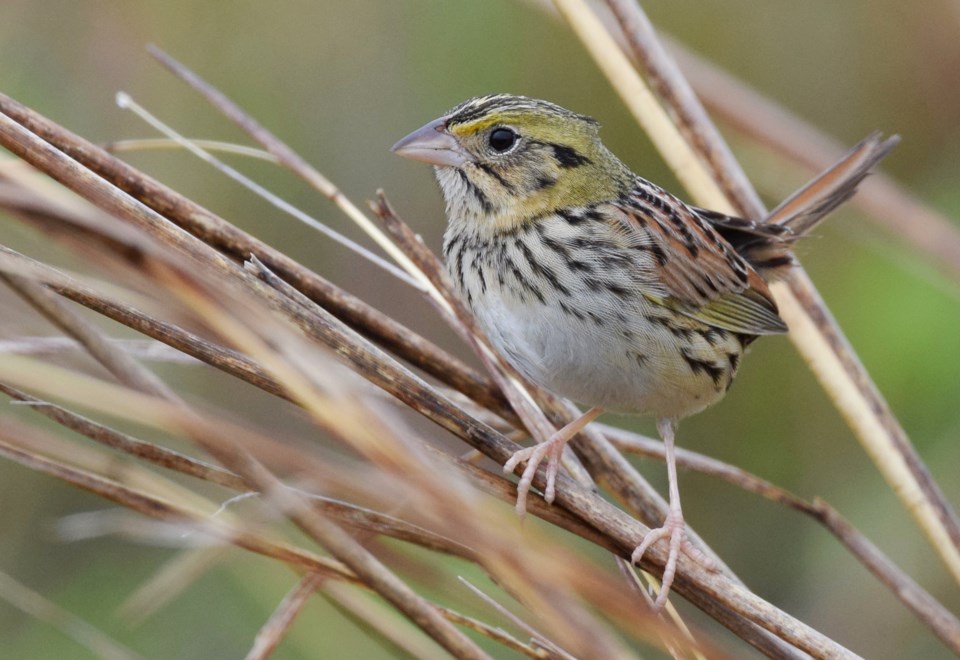The sweet sound of a Henslow’s sparrow’s song was something Chris Earley never expected to hear.
The exciting observation occurred in 2022 at Eastview Pollinator Park, on the former Eastview landfill site in the east end of Guelph.
“I first heard the bird singing while I was out doing a yearly survey and I couldn't believe it. It was one of those once-in-a-lifetime events,” said Earley, interpretive biologist at the University of Guelph Arboretum and volunteer with Pollination Guelph.
Earley recorded the song and continued to monitor the site for the next few weeks.
“The bird sang from the same location for over a week, putting it in the category of 'probable' for the Ontario Breeding Bird Atlas. It was beyond exciting, especially knowing that it chose a restored grassland site within the city limits,” he said.
Eastview Pollinator Park is a 45-hectare grassland site managed by Pollination Guelph volunteers.
Since 2008, Pollination Guelph, a federally incorporated charitable organization, has strived to promote a better understanding of the importance of pollinators, to conserve and develop pollinator habitat and showcase pollinator projects. These activities are accomplished through the goals of education, research, community outreach, advocacy and conservation.
Researchers and volunteers have been conducting regular bird and pollinator surveys at Eastview Pollinator Park and over the years have noted multiple species at risk, including the American bumble bee, yellow-banded bumble bee, monarch, bobolink, eastern meadowlark and barn swallow.
The discovery of a Henslow’s sparrow took place in spring, last year.
This endangered species is extremely rare in Ontario, with only 34 noted occurrences in the last 20 years and 69 observations since 2008.
According to Pollination Guelph, due to its rarity and the massive attention by bird enthusiasts this finding would have resulted in, volunteers were not allowed to announce the discovery until this fall.
"The fact that this bird chose the Eastview Pollinator Park as a breeding territory out of all the locations in southern Ontario shows the value of the grassland there, and the value of preserving, restoring and creating habitats even within city boundaries,” said Victoria MacPhail, co-chair of Pollination Guelph.
"The Eastview Pollinator Park is a real oasis in the city. In the late summer when the grass is tall, you can hardly imagine you are still in the city when you walk through the site. It's full of bird song and insect life.”
The Henslow’s sparrow can be distinguished from other sparrows by its combination of chestnut brown wings, intricately patterned olive-green head and back of neck, black and brown streaked back, and by its flat-headed, short-tailed profile.
This small, secretive bird is hard to spot, and is most often located by its 'odd' song, a dry, thin, metallic sound usually mistaken for an insect.
The main threat to the Henslow's sparrow is loss of open field prairie habitat. Much of its habitat has been converted to pasture, crop lands or tree plantations and housing developments.
While the site at Eastview Pollinator Park site is not open to the general public, Pollination Guelph does offer tours.
And, it’s not the only site the organization is involved with.
The Clair Road Emergency Services Centre site, once surrounded by dead and dying turf, is slowly being converted into a drought-tolerant meadow. It is open to the public, with short trails winding through it.
The Gosling Pollinator Garden at Hospice Wellington, at the corner of Scottsdale and Kortright roads, is also designed and maintained by Pollination Guelph volunteers and offers another example of how native plants that support pollinating insects can be used in urban landscaping for businesses and homes.
As a result of Pollination Guelph’s outreach and education work, many other patches of habitat have been created by the City of Guelph, community groups and community members. However, Pollination Guelph says it knows a lot less about the animal visitors to those areas, and is calling on members of the public to help fill in the gap.
“Anyone with a camera can take photos of the plants, birds and insects they see at any of our planting sites or other areas in the City, upload them to iNaturalist.org via a phone app or a website, and have the species identified by other naturalists. Plus all observations are automatically added to Pollination Guelph’s Projects on iNaturalist, giving us a better understanding of the impact of these areas of habitat.” said Pollination Guelph Board Member Lorne Widmer.
"In just five hours last September, six volunteers from the Canadian Conservation Corps Guelph Flex Team made 640 observations to iNaturalist from the Hospice Wellington site, the Clair Road site, and a third site at Alectra Utilities. Species observed at each site totalled 155, 124 and 49 respectively. This is remarkable, given that each of these sites was almost entirely covered in sod just a few years ago.”
MacPhail says the beauty of iNaturalist is that you don’t need to know how to identify the species at all.
"Just take a photo, upload it to the website or submit it through the app, and volunteers will help to identify it for you,” MacPhail said.
“People are literally finding rare species and even new species all the time just by photographing the animals in their gardens or local parks, and the data is invaluable.”
Pollination Guelph recognizes World Habitat Day on Oct 2 and World Animal Day on Oct 4 to highlight the value of pollinator habitats and to announce the discovery of several rare species at pollinator habitat sites in Guelph. The organization challenges everyone to take a walk and see what wildlife they can find, and to give some thought to the habitats they require.



